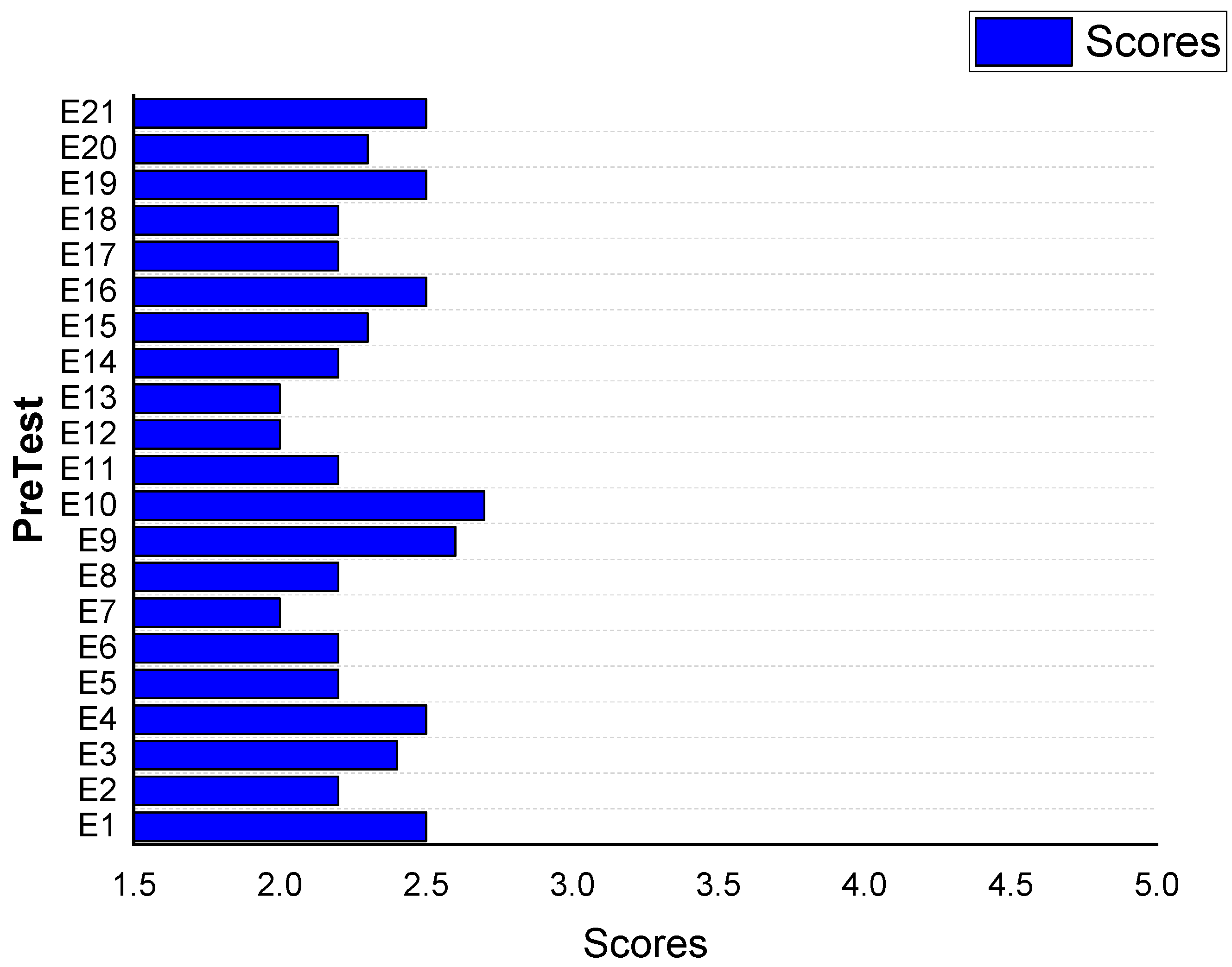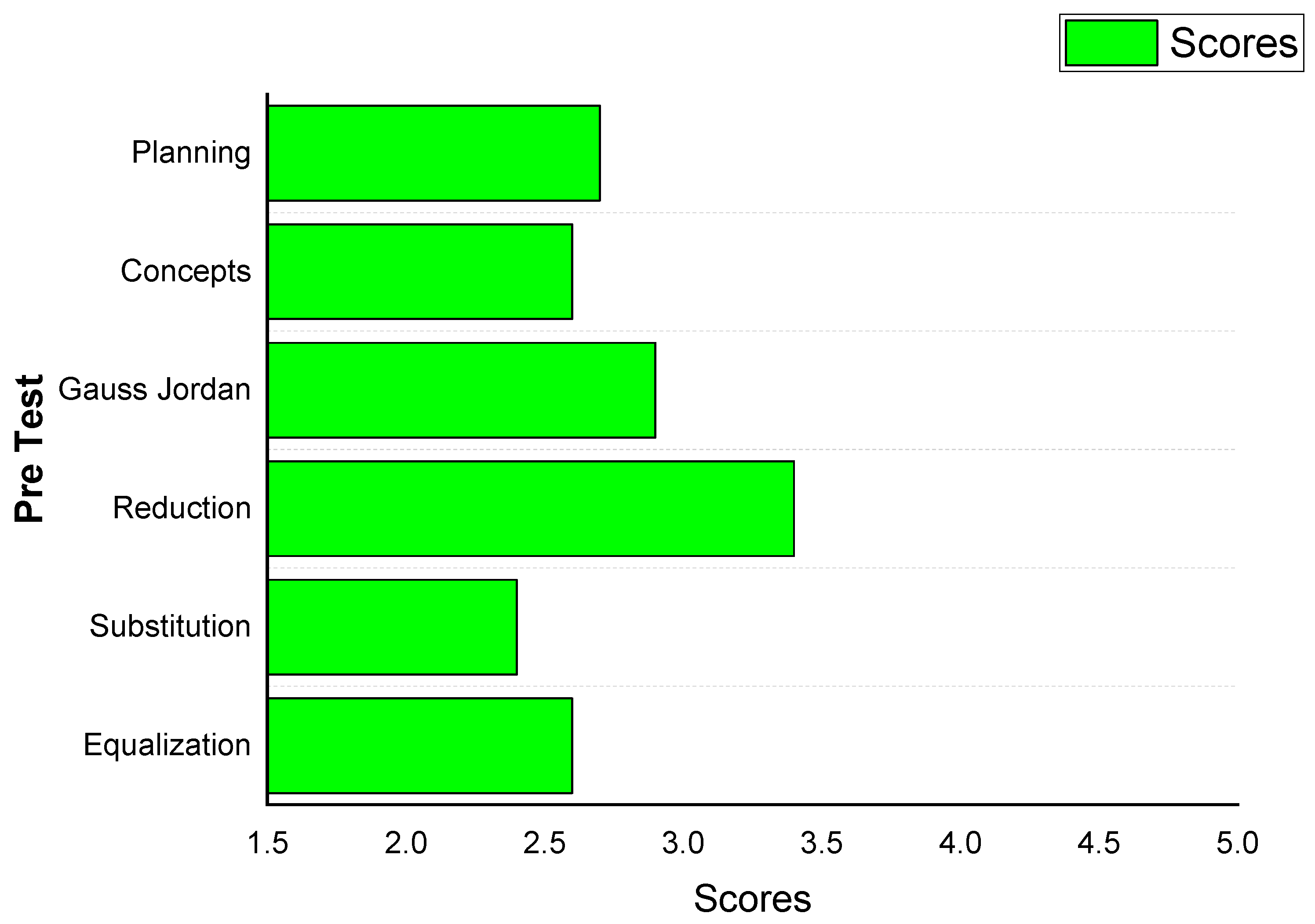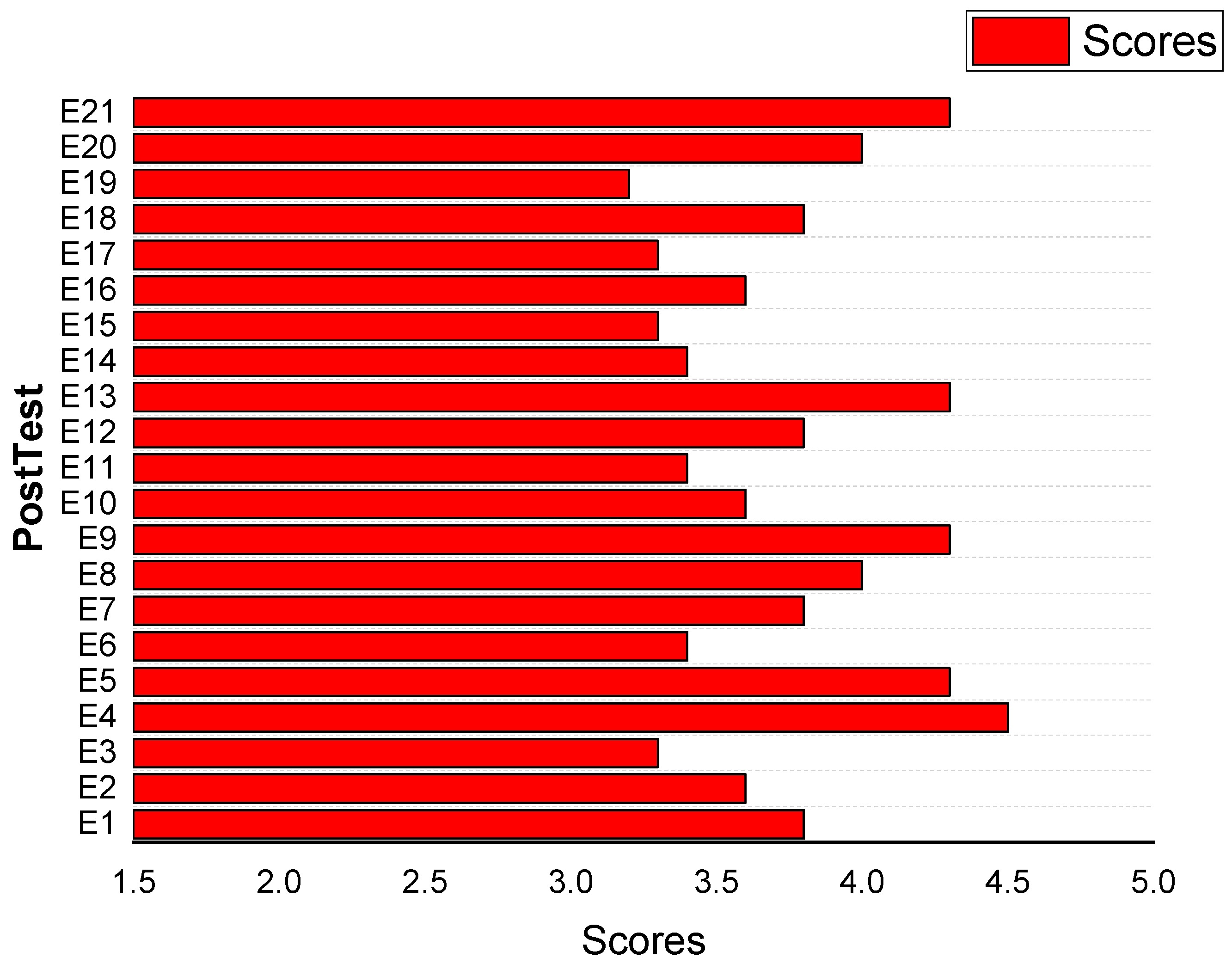Enhancing Mathematical Education Through Mobile Learning: A Problem-Based Approach
Abstract
:1. Introduction
Literature Review
- Native apps are computer programs created to work on a specific operating system so that their stability is ensured for that system, and they are downloaded from the App Store (Play Store for Android or iOS).
- Web apps are applications that can be accessed online from any mobile device. There is no requirement for a specific operating system. They are characterized by implementing databases and are coded in programming languages, such as CSS, HTML, or JavaScript, which allow the integration of various web developments.
- Native web apps are a type of hybrid application that combines the advantages of the web development framework and native applications. It is developed in programming languages for web design so that they are multiplatform, and, additionally, they can be downloaded from the Play Store.
2. Materials and Methods
App Development
3. Results
4. Discussion
- Finding interpretation: This study showed that the training of students through the expository method makes it difficult to adapt to the implementation of other learning strategies, such as the problem-solving methodology. The expository method is the predominant strategy in traditional teaching, where the teacher is the center of the educational process, and the student assumes a passive role (Karan & Brown, 2022), while PBL is a methodology that encourages the construction of knowledge by the student (Zakaria et al., 2025). This methodological clash is felt at the beginning of the implementation of the didactic sequence with PBL and the mobile application (Herdianto & Indriati, 2021; Srikan et al., 2021). A reasonable amount of time is required for the application of the new strategy so that the adaptation achieves the expected effects (Susilawati & Supriyatno, 2023; Nasori et al., 2022; Setyani & Susilowati, 2022). The results of the research coincide with the statements of Jahnke and Liebscher (2020). It is confirmed that the use of mobile applications for educational purposes promotes the motivation to learn and favors the development of skills for communication, teamwork, and creativity in students, especially when it involves the analysis and solution of problems related to the context. Additionally, the explanatory videos, included in a didactic way within the app, contributed to the assimilation of the procedures to apply each method of the system of linear equations. In relation to the didactic videos, Ortega González et al. (2019) indicate that they are a powerful tool to mediate learning due to their functions of informing, motivating, playing, expressing, and evaluating.
- Theoretical implications: The research allows us to show that the pedagogical use of videos within the framework of a didactic has satisfying results. However, videos also fulfill a guiding function since they guide the interpretation of procedural structures. PBL mediated with a mobile educational application allows the development of some interpersonal skills, in the same sense as stated by Chung et al. (2019). The educational strategy contributed to the strengthening of collaborative work. Other interpersonal skills evidenced in the research include the ability to argue ideas in front of a workgroup, respect for the opinions and contributions of colleagues, and decision-making based on discussion and analysis within the team.
- Practical implications: In this research, it is possible to confirm that mobile devices contribute to the methodological change required to respond to the current educational needs of the subjects. According to what was expressed by Prahani et al. (2022), the use of mobile educational applications facilitates the student’s autonomous learning, an essential skill for training processes in the 21st century. In this sense, with mobile devices, it is possible to access information without time or place limits (Chan et al., 2023). Therefore, students can access the content, activities, and assessment in real time, learning at their own pace and according to their needs and interests. Additionally, implementing mobile learning allows for choosing multiple work strategies, establishing the degree of depth of the thematic content, and various forms of assessment (Sophonhiranrak, 2021).
- Limitations and future research: The research allows us to affirm that PBL mediated with an app favors the assessment processes. The teacher can assess the contributions of group work, interpersonal relationships with team members, leadership, motivation, assertive communication, and the quality of contributions, leading to a more comprehensive assessment tailored to student achievements. In this regard, a larger sample in other regions and universities would be useful to corroborate the study.
5. Conclusions
Author Contributions
Funding
Institutional Review Board Statement
Informed Consent Statement
Data Availability Statement
Conflicts of Interest
References
- Al-Adwan, A. S., Albelbisi, N. A., Hujran, O., Al-Rahmi, W. M., & Alkhalifah, A. (2021). Developing a holistic success model for sustainable e-learning: A structural equation modeling approach. Sustainability, 13(16), 9453. [Google Scholar] [CrossRef]
- Amjad, A. I., Habib, M., Tabbasam, U., Alvi, G. F., Taseer, N. A., & Noreen, I. (2023). The impact of brain-based learning on students’ intrinsic motivation to learn and perform in mathematics: A neuroscientific study in school psychology. International Electronic Journal of Elementary Education, 16(1), 111–122. [Google Scholar] [CrossRef]
- Bustamante-Mora, A., Diéguez-Rebolledo, M., Hormazábal, Y., Valdés, Y., & Cadena, R. (2023). Learning models for higher education in engineering: Motivation, self-determination, and the role of information and communication technologies. Sustainability, 15, 12869. [Google Scholar] [CrossRef]
- Chan, C. L., Shroff, R. H., Tsang, W. K., Ting, F. S., & Garcia, R. C. (2023). Assessing the effects of a collaborative problem-based learning and peer assessment method on junior secondary students’ learning approaches in mathematics using interactive online whiteboards during the COVID-19 pandemic. International Journal of Mobile Learning and Organisation, 17(1–2), 6–31. [Google Scholar]
- Choon-Eng Gwee, M. (2008). Globalization of problem-based learning (PBL): Cross-cultural implications. The Kaohsiung Journal of Medical Sciences, 24, S14–S22. [Google Scholar]
- Chung, C. J., Hwang, G. J., & Lai, C. L. (2019). A review of experimental mobile learning research in 2010–2016 based on the activity theory framework. Computers & Education, 129, 1–13. [Google Scholar]
- Dita, P. P. S., Utomo, S., & Sekar, D. A. (2021). Implementation of problem-based learning (PBL) on interactive learning media. Journal of Technology and Humanities, 2(2), 24–30. [Google Scholar]
- Elkhair, Z., & Abdul Mutalib, A. (2019). Mobile learning applications: Characteristics, perspectives, and future trends. International Journal of Interactive Digital Media, 5(1), 18–21. [Google Scholar]
- Elliott, J. (2023). The relationship between ‘understanding’ and ‘developing’ teachers’ thinking. In Routledge Library Editions: Education Mini-Set N Teachers & Teacher Education Research 13 (pp. 189–221). Routledge. [Google Scholar]
- Enríquez, J. G., & Casas, S. I. (2013). Usabilidad en aplicaciones móviles. Informes Científicos Técnicos-UNPA, 5(2), 25–47. [Google Scholar] [CrossRef]
- Gonzalez-Argote, J., & Castillo-González, W. (2024). Problem-based learning (PBL), review of the topic in the context of health education. Seminars in Medical Writing and Education, 3, 57–57. [Google Scholar] [CrossRef]
- González, I. M. O., Álvarez, G. A. R., & Suárez, C. A. H. (2019). Uso del video como estrategia pedagógica para el desarrollo de la competencia escritora en estudiantes de educación básica. Revista Perspectivas, 4(2), 52–63. [Google Scholar]
- Hair, J. F., Jr., Anderson, R. E., Tatham, R. L., & Black, W. C. (1995). Multivariate data analysis with readings. Prentice-Hall. [Google Scholar]
- Herdianto, E. N., & Indriati, D. (2021). E-book based on mobile learning used problem-based learning (PBL) model to improve problem-solving ability in statistical material. Journal of Physics: Conference Series, 1808(1), 012066. [Google Scholar]
- Hernández-Sampieri, R., & Mendoza, C. (2023). Metodología de la investigación: Las rutas cuantitativa, cualitativa y mixta. McGraw-Hill. [Google Scholar]
- Islamiati, A., Fitria, Y., Sukma, E., Fitria, E., & Oktari, S. T. (2024). The influence of the problem-based learning (PBL) model and learning style on the thinking abilities. Jurnal Penelitian Pendidikan IPA, 10(4), 1934–1940. [Google Scholar]
- Isnawan, M. G., Sudirman, S., Sukarma, I. K., Wahyuni, F., & Alsulami, N. M. (2023). Optimizing students’ mathematical problem-solving abilities through geoboard-assisted didactic design on triangular number pattern material. Journal of Didactic Mathematics, 4(3), 200–213. [Google Scholar] [CrossRef]
- Jahnke, I., & Liebscher, J. (2020). Three types of integrated course designs for using mobile technologies to support creativity in higher education. Computers & Education, 146, 103782. [Google Scholar]
- Janiesch, C., Zschech, P., & Heinrich, K. (2021). Machine learning and deep learning. Electronic Markets, 31(3), 685–695. [Google Scholar]
- Karan, E., & Brown, L. (2022). Enhancing student’s problem-solving skills through project-based learning. Journal of Problem Based Learning in Higher Education, 10(1), 74–87. [Google Scholar]
- Kilroy, D. A. (2004). Problem based learning. Emergency Medicine Journal, 21(4), 411–413. [Google Scholar]
- Krieglstein, F., Schneider, S., Gröninger, J., Beege, M., Nebel, S., Wesenberg, L., Suren, M., & Rey, G. D. (2023). Exploring the effects of content-related segmentations and metacognitive prompts on learning with whiteboard animations. Computers & Education, 194, 104702. [Google Scholar]
- Marchy, F., Murni, A., & Muhammad, I. (2022). The effectiveness of using problem-based learning (PBL) in mathematics problem-solving ability for junior high school students. AlphaMath: Journal of Mathematics Education, 8(2), 185–198. [Google Scholar]
- Mystakidis, S., Christopoulos, A., & Pellas, N. (2022). A systematic mapping review of augmented reality applications to support STEM learning in higher education. Education and Information Technologies, 27(2), 1883–1927. [Google Scholar] [CrossRef]
- Nasori, A., Putra, I., Sari, N., & Dwijayanti, N. S. (2022). Challenges digital literacy in era of Society 5.0: Effectiveness problem-based learning with mobile learning to accelerate digital literacy. Journal on Teacher Education, 4(2), 97–106. [Google Scholar]
- Peter, L. (2022). Information and communication technologies and education. In I. Panagoret, & G. Gorghiu (Eds.), International conference globalization, innovation and development: Trends and prospects (G.I.D.T.P.) (pp. 344–353). Editura Lumen. [Google Scholar]
- Poçan, S., Altay, B., & Yaşaroğlu, C. (2023). The effects of mobile technology on learning performance and motivation in mathematics education. Education and Information Technologies, 28(1), 683–712. [Google Scholar] [CrossRef] [PubMed]
- Pombo, L., & Marques, M. M. (2020). The potential educational value of mobile augmented reality games: The case of EduPARK app. Education Sciences, 10, 287. [Google Scholar] [CrossRef]
- Prahani, B., Jatmiko, B., Hariadi, B., Sunarto, D., Sagirani, T., Amelia, T., & Lemantara, J. (2022). Blended web mobile learning (BWML) model to improve students’ higher-order thinking skills. International Journal of Emerging Technologies in Learning (iJET), 15(11), 42–55. [Google Scholar] [CrossRef]
- Prince, K. J., Van Eijs, P. W., Boshuizen, H. P., Van Der Vleuten, C. P., & Scherpbier, A. J. (2005). General competencies of problem-based learning (PBL) and non-PBL graduates. Medical Education, 39(4), 394–401. [Google Scholar] [CrossRef]
- Qashou, A. (2021). Influencing factors in M-learning adoption in higher education. Education and Information Technologies, 26(2), 1755–1785. [Google Scholar] [CrossRef]
- Salam, S. (2022). A systemic review of problem-based learning (PBL) and computational thinking (CT) in teaching and learning. International Journal of Humanities and Innovation (IJHI), 5(2), 46–52. [Google Scholar] [CrossRef]
- Setyani, N. S., & Susilowati, L. (2022). The effect of e-problem-based learning on students’ interest, motivation, and achievement. International Journal of Instruction, 15(3), 503–518. [Google Scholar]
- Sitar-Taut, D. A., & Mican, D. (2021). Mobile learning acceptance and use in higher education during social distancing circumstances: An expansion and customization of UTAUT2. Online Information Review, 45(5), 1000–1019. [Google Scholar] [CrossRef]
- Smith, K., Maynard, N., Berry, A., Stephenson, T., Spiteri, T., Corrigan, D., Mansfield, J., Ellerton, P., & Smith, T. (2022). Principles of problem-based learning (PBL) in STEM education: Using expert wisdom and research to frame educational practice. Education Sciences, 12(10), 728. [Google Scholar]
- Sophonhiranrak, S. (2021). Features, barriers, and influencing factors of mobile learning in higher education: A systematic review. Heliyon, 7(4), e06696. [Google Scholar] [PubMed]
- Srikan, P., Pimdee, P., Leekitchwatana, P., & Narabin, A. (2021). A problem-based learning (PBL) and teaching model using a cloud-based constructivist learning environment to enhance Thai undergraduate creative thinking and digital media skills. International Journal of Interactive Mobile Technologies, 15(22), 68. [Google Scholar]
- Ssemugenyi, F. (2023). Teaching and learning methods compared: A pedagogical evaluation of problem-based learning (PBL) and lecture methods in developing learners’ cognitive abilities. Cogent Education, 10(1), 2187943. [Google Scholar]
- Strzelecki, A. (2024). To use or not to use ChatGPT in higher education? A study of students’ acceptance and use of technology. Interactive Learning Environments, 32(9), 5142–5155. [Google Scholar]
- Susilawati, S., & Supriyatno, T. (2023). Problem-based learning model in improving critical thinking ability of elementary school students. Advances in Mobile Learning Educational Research, 3(1), 638–647. [Google Scholar]
- Van de Ven, G. M., Tuytelaars, T., & Tolias, A. S. (2022). Three types of incremental learning. Nature Machine Intelligence, 4(12), 1185–1197. [Google Scholar] [CrossRef]
- Van Griethuijsen, R. A., van Eijck, M. W., Haste, H., Den Brok, P. J., Skinner, N. C., Mansour, N., Gencer, A. S., & BouJaoude, S. (2015). Global patterns in students’ views of science and interest in science. Research in Science Education, 45, 581–603. [Google Scholar]
- Voshaar, J., Knipp, M., Loy, T., Zimmermann, J., & Johannsen, F. (2023). The impact of using a mobile app on learning success in accounting education. Accounting Education, 32(2), 222–247. [Google Scholar]
- Vygotsky, L. S. (1977). The development of higher psychological functions. Soviet Psychology, 15(3), 60–73. [Google Scholar]
- Wardoyo, C., Satrio, Y. D., Narmaditya, B. S., & Wibowo, A. (2021). Gamification in economics and its impact on students’ achievement: Lesson from COVID-19 in Indonesia. Cypriot Journal of Educational Sciences, 16(3), 1194–1203. [Google Scholar]
- Wells, S., Warelow, P., & Jackson, K. (2009). Problem based learning (PBL): A conundrum. Contemporary Nurse, 33(2), 191–201. [Google Scholar]
- Yaniawati, P., Fisher, D., Permadi, Y. D., & Yatim, S. A. M. (2023). Development of mobile-based digital learning materials in blended learning oriented to students’ mathematical literacy. International Journal of Information and Education Technology, 13(9), 1338–1347. [Google Scholar]
- Zakaria, M. I., Abdullah, A. H., Alhassora, N. S. A., Osman, S., & Ismail, N. (2025). The impact of m-learning and problem-based learning teaching method on students’ motivation and academic performance. International Journal of Instruction, 18(1), 503–518. [Google Scholar]
- Zakaria, M. I., Hanid, M. F. A., & Hassan, R. (2023). Combination of M-learning with problem-based learning: Teaching activities for mathematics teachers. International Journal of Interactive Mobile Technologies, 17(9), 4–19. [Google Scholar]




| Beginning | |||
|---|---|---|---|
| Stages of PBL | Resources/Materials | Description of Activities | Time |
| Explore the issue | Classroom space in which students meet in groups of 4 members reading and talking to analyze the problem. | Problem: In the construction of wooden boxes, a carpenter needs to cut a 20 cm long board into two parts that have a difference of 6 cm between them. Determine the length of the parts. | 15 min |
| Try to solve the problem with what you know | Each member of the group gives an idea of how to solve the problem with what they know. All members should participate. All members must reach a joint solution. | The above situation can be solved by proposing a system of two linear equations of the first degree with two unknowns. | 10 min |
| Identify what you do not know to solve the problem | On a sheet of paper, make a list of the information that is required and should be consulted to solve the problem. Develop the information individually and share it with everyone. | In this situation, what would be the unknowns? How would the equations be posed? Propose a system of two equations with two unknowns and try to solve it. Relate the thinking of other group members. | 10 min |
| Development | |||
| ABP Stages | Resources/Materials | Description of Activities | Time |
| Prioritize learning needs | Each group defines learning objectives, and resources, and distributes consultation tasks among participants. | Know what the Equalization method consists of and the steps necessary to solve a problem, | 10 min |
| Self-study and preparation | Use the EQUALINEALES mobile educational application. | Use the EQUALINEALES mobile application to determine what the Equalization method consists of and the necessary steps to solve a system of linear equations with two unknowns. | 30 min |
| Closing | |||
| ABP Stages | Resources/Materials | Description of Activities | Time |
| Share information among group members | Use the EQUALINEALES mobile educational app | Take into account the information present in the mobile application: generalities, methods, and procedures for solving problems. | 20 min |
| Apply knowledge to the solution | Use the EQUALINEALES mobile educational application in the X Challenge option | Provide solutions to the problems raised within the APP. | 10 min |
| Assess new knowledge | Use the EQUALINEALES mobile educational application in the Evaluation option | Self-evaluation of the exercise carried out and the group analysis, explaining the procedures put into practice by each group. | 15 min |
Disclaimer/Publisher’s Note: The statements, opinions and data contained in all publications are solely those of the individual author(s) and contributor(s) and not of MDPI and/or the editor(s). MDPI and/or the editor(s) disclaim responsibility for any injury to people or property resulting from any ideas, methods, instructions or products referred to in the content. |
© 2025 by the authors. Licensee MDPI, Basel, Switzerland. This article is an open access article distributed under the terms and conditions of the Creative Commons Attribution (CC BY) license (https://creativecommons.org/licenses/by/4.0/).
Share and Cite
Martínez-Gómez, J.; Nicolalde, J.F. Enhancing Mathematical Education Through Mobile Learning: A Problem-Based Approach. Educ. Sci. 2025, 15, 462. https://doi.org/10.3390/educsci15040462
Martínez-Gómez J, Nicolalde JF. Enhancing Mathematical Education Through Mobile Learning: A Problem-Based Approach. Education Sciences. 2025; 15(4):462. https://doi.org/10.3390/educsci15040462
Chicago/Turabian StyleMartínez-Gómez, Javier, and Juan Francisco Nicolalde. 2025. "Enhancing Mathematical Education Through Mobile Learning: A Problem-Based Approach" Education Sciences 15, no. 4: 462. https://doi.org/10.3390/educsci15040462
APA StyleMartínez-Gómez, J., & Nicolalde, J. F. (2025). Enhancing Mathematical Education Through Mobile Learning: A Problem-Based Approach. Education Sciences, 15(4), 462. https://doi.org/10.3390/educsci15040462







